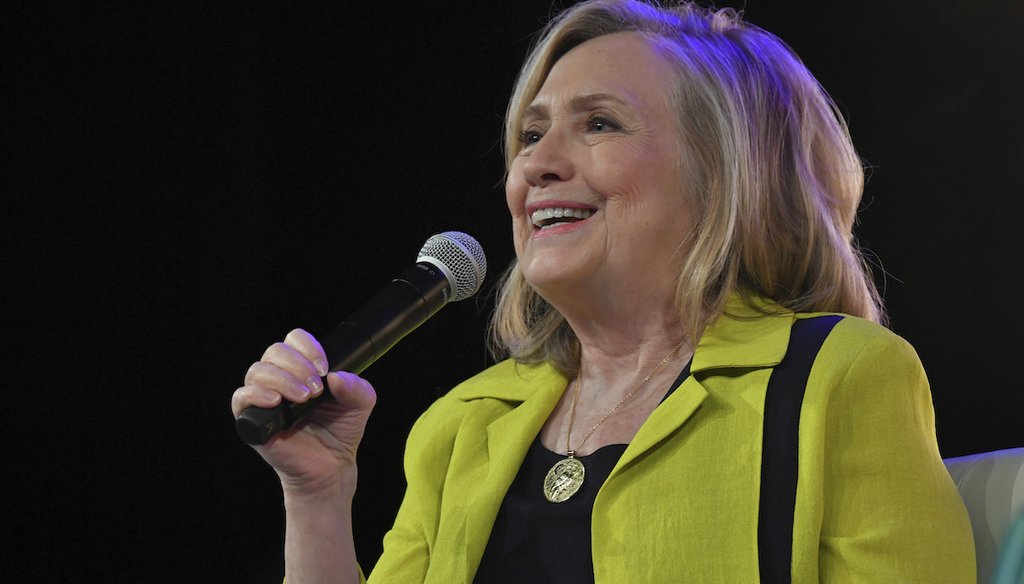Stand up for the facts!
Our only agenda is to publish the truth so you can be an informed participant in democracy.
We need your help.
I would like to contribute

Hillary Clinton attends the 'Here's to the Ladies Panel: Hillary Rodham Clinton' at BroadwayCon at the Manhattan Center on July 8, 2022 in New York. (AP)
Clinton exaggerates absence of classified information in her emails
If Your Time is short
-
In a 2019 report, the State Department said none of former Secretary of State Hillary Clinton’s emails were marked as classified.
-
The report said 38 people were responsible for 91 violations of including details that could be considered classified in their email exchanges with Clinton.
-
No documents included in the emails carried classified markings.
Former Secretary of State Hillary Clinton pushed back against comparisons between her email probe and the search on former President Donald Trump’s Florida home. In a Sept. 6 Twitter thread, Clinton said "the right is trying to make this about me again.
"The fact is that I had zero emails that were classified," Clinton claimed. "I’m more tired of talking about this than anyone, but here we are."
I can’t believe we’re still talking about this, but my emails…
— Hillary Clinton (@HillaryClinton) September 6, 2022
As Trump’s problems continue to mount, the right is trying to make this about me again. There’s even a “Clinton Standard."
The fact is that I had zero emails that were classified.
We have previously compared Clinton’s emails with the FBI’s search on Mar-a-Lago and have fact-checked other claims she has made about her emails.
Over the years, the facts about the emails have become clearer. In 2016, Clinton said she "never received nor sent any material that was marked classified" on her private email server while secretary of state. We rated that False. Since then, the State Department and Justice Department have published new information from their own investigations of the emails.
Some of Clinton’s emails contained classified information, but none were found to be marked as such.
What we know about the markings in Clinton’s emails
Clinton’s email troubles started in 2014, when the House Select Committee on Benghazi asked the State Department for all of her emails. The department didn’t have them all because, instead of using only the State Department email system (with an email address ending in @state.gov), Clinton used a personal email address (ending in @clintonemail.com) housed on private servers in her Chappaqua, New York, home.
In 2014, Clinton’s lawyers combed through the private server and turned over about 30,000 work-related emails to the State Department and deleted the rest, which Clinton said involved personal matters, such as her daughter’s wedding plans.
On July 5, 2016, the FBI released its findings on an investigation into Clinton’s emails. Then-FBI Director James Comey said of the 30,000 emails, 113 were determined to have contained classified information at the time they were sent. Comey said three of those had a marking indicating they were classified, and that 2,000 more were marked as classified after the fact by various agencies.
The next day, the State Department explained what the three document markings suggesting classified material were all about. They had to do with what is known as "call sheets," not classified material.
Before a secretary of state calls a foreign leader, staff members prepare a guide known as a call sheet. It gives the context for the call and the key points to hit during the conversation. Early in the process, a call sheet might be marked as sensitive, but by the time it reaches the secretary, it isn’t.
"The process is then to move the call sheet, to change its markings to unclassified and deliver it to the secretary in a form that he or she can use," said then-State Department spokesperson John Kirby July 6, 2016, adding that the confidential markings resulted from human error.
In a July 7, 2016, congressional hearing, Comey said he had not heard what the State Department had said about the call sheets. He explained that classified documents come with headers that give the classification level. Comey acknowledged that the documents in Clinton’s email had no headers. Asked whether the lack of a header would have told Clinton that the material was unclassified, Comey said, "That would be a reasonable inference."
The State Department cited Clinton for three security violations for failing to follow department protocols. In 2017, after she appealed, the department dropped two, but affirmed one.
A 2018 Justice Department review of how the FBI handled its investigation noted that prosecutors found no evidence that Clinton and her colleagues ever intended to put classified materials into their email exchanges.
"The emails in question lacked proper classification markings," the report said. "The senders often refrained from using specific classified facts or terms in emails and worded emails carefully in an attempt to ‘talk around’ classified information."
State Department’s own review of Clinton’s email use
The State Department reviewed thousands of documents in Clinton’s emails, and questioned dozens of State Department employees. The investigation took place primarily during Donald Trump’s presidency, running from July 2016 to September 2019.
It focused on the general problem of spillage, the sharing of unmarked but nevertheless classified details. The investigation found 38 people were responsible for 91 violations. It found 497 additional violations in which no one could be held culpable.
The State Department concluded that Clinton’s use of a private email server "carried an increased risk of compromise or inadvertent disclosure." (The 2018 Justice Department review found no evidence that the server was hacked.)
On the other hand, State Department investigators concluded that although staff members sometimes shared information that they shouldn’t have, by and large, they "were aware of security policies and did their best to implement them in their operations."
They noted that "none of the emails at issue in this review were marked as classified." They also said there was "no persuasive evidence of systemic, deliberate mishandling of classified information."
Clinton’s longtime attorney, David Kendall, highlighted the State Department’s findings as evidence for Clinton’s claim.
Ambiguities in the classification system
There is debate over the classification of material in the emails.
"There is no one standard for classification," Thomas Blanton, the director of the National Security Archive at George Washington University, told PolitiFact in early August. "It's in the eye of the beholder. We have published thousands of examples of documents and parts of documents that one agency considered declassified and another agency kept classified; and in hundreds of cases, the difference was between two components of the same agency."
Blanton said that in Clinton’s case, he saw signs of a rift between the State Department and intelligence agencies. The State Department reviewers, he said, initially found no classified material, while the intelligence agencies said there were potentially hundreds of instances.
Our ruling
Clinton claimed she had "zero emails that were classified."
At the conclusion of all investigations, no documents included in her emails were found to be marked as classified.
However, hundreds of bits of information that State Department officials considered classified did end up in emails on Clinton’s private server.
Clinton is technically correct, but she sidesteps the references to classified information that staffers introduced into the email chains.
We rate this claim Half True.
Our Sources
Email exchange with David Merrill, Hillary Clinton’s attorney, Sep. 8, 2022
Phone interview with Elizabeth Goitein, Senior Director of Liberty & National Security at Brennan Center for Justice at NYU Law, Sep. 9, 2022
PolitiFact, Read the Mar-a-Lago search warrant, what agents took, Aug. 12, 2022
Hillary Clinton, Tweet, Sep. 6, 2022
US House Committee on Government Oversight and Reform, Hearing: Comey testimony, July 7, 2016
U.S. Justice Department, A Review of Various Actions by the Federal Bureau of Investigation and Department of Justice in Advance of the 2016 Election, June 2018
PolitiFact, Comparing Hillary Clinton’s emails and Donald Trump’s boxes of files, Aug. 9, 2022
Politifact, Fact-checking Benghazi: The rhetoric hasn't matched up with reality, May 16, 2014
FBI, Statement by FBI Director James B. Comey on the Investigation of Secretary Hillary Clinton’s Use of a Personal E-Mail System, July, 5 2016
House Committee on Oversight and Reform, FBI Director Comey: Emails Were Not Properly Marked as Classified, July 7, 2016
U.S. Department of State, Daily Press Briefing, July 6, 2016
Department of State Office of Information Security, DS Report on Security Incidents Related to Potentially Classified Emails sent to Former Secretary of State Clinton's Private Email Serve, Sep. 13, 2019
USC Dornsife, What is classified information, and who gets to decide?, May 17, 2017
PolitiFact, Hillary Clinton says none of her emails had classification headers, Sep. 7, 2016
Browse the Truth-O-Meter
More by Jon Greenberg
Clinton exaggerates absence of classified information in her emails
Support independent fact-checking.
Become a member!
In a world of wild talk and fake news, help us stand up for the facts.























































